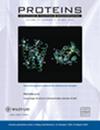通过硅学筛选、分子动力学模拟和结合自由能确定可破坏 p53 稳定性并减少与 DNA 结合的单点突变
IF 3.2
4区 生物学
Q2 BIOCHEMISTRY & MOLECULAR BIOLOGY
引用次数: 0
摘要
考虑到 p53 作为肿瘤抑制蛋白的关键作用,在潜在的有害 p53 突变出现在人群中之前,对其进行主动识别和鉴定至关重要。为此,研究人员采用了四种计算预测工具--SIFT、Polyphen-2、PHD-SNP 和 MutPred2,利用基于序列和机器学习的算法来识别可能影响 p53 结构、动力学和与 DNA 结合的潜在有害 p53 nsSNPs(非同义单核苷酸多态性)。这些计算方法确定了 C141Y、C238S 和 L265P 这三个变异对 p53 的稳定性有害。此外,分子动力学(MD)模拟显示,与原生蛋白相比,所有这三种变体都表现出更高的结构灵活性,尤其是 C141Y 和 L265P 突变。因此,由于突变体 p53 结构的改变,与野生型 p53 与 DNA 结合(14 μM)相比,这三种变体的 DNA 结合亲和力下降了约 1.8 至 9.7 倍。值得注意的是,L265P 突变体的结合亲和力降低了约 10 倍。因此,p53 中存在 L265P 突变可能会对人类造成巨大风险。鉴于 p53 能调节肿瘤的异常生长,这项研究对监测工作和抗癌疗法的开发具有重要意义。本文章由计算机程序翻译,如有差异,请以英文原文为准。
In Silico Screening, Molecular Dynamics Simulation and Binding Free Energy Identify Single‐Point Mutations That Destabilize p53 and Reduce Binding to DNA
Considering p53's pivotal role as a tumor suppressor protein, proactive identification and characterization of potentially harmful p53 mutations are crucial before they appear in the population. To address this, four computational prediction tools—SIFT, Polyphen‐2, PhD‐SNP, and MutPred2—utilizing sequence‐based and machine‐learning algorithms, were employed to identify potentially deleterious p53 nsSNPs (nonsynonymous single nucleotide polymorphisms) that may impact p53 structure, dynamics, and binding with DNA. These computational methods identified three variants, namely, C141Y, C238S, and L265P, as detrimental to p53 stability. Furthermore, molecular dynamics (MD) simulations revealed that all three variants exhibited heightened structural flexibility compared to the native protein, especially the C141Y and L265P mutations. Consequently, due to the altered structure of mutant p53, the DNA‐binding affinity of all three variants decreased by approximately 1.8 to 9.7 times compared to wild‐type p53 binding with DNA (14 μM). Notably, the L265P mutation exhibited an approximately ten‐fold greater reduction in binding affinity. Consequently, the presence of the L265P mutation in p53 could pose a substantial risk to humans. Given that p53 regulates abnormal tumor growth, this research carries significant implications for surveillance efforts and the development of anticancer therapies.
求助全文
通过发布文献求助,成功后即可免费获取论文全文。
去求助
来源期刊

Proteins-Structure Function and Bioinformatics
生物-生化与分子生物学
CiteScore
5.90
自引率
3.40%
发文量
172
审稿时长
3 months
期刊介绍:
PROTEINS : Structure, Function, and Bioinformatics publishes original reports of significant experimental and analytic research in all areas of protein research: structure, function, computation, genetics, and design. The journal encourages reports that present new experimental or computational approaches for interpreting and understanding data from biophysical chemistry, structural studies of proteins and macromolecular assemblies, alterations of protein structure and function engineered through techniques of molecular biology and genetics, functional analyses under physiologic conditions, as well as the interactions of proteins with receptors, nucleic acids, or other specific ligands or substrates. Research in protein and peptide biochemistry directed toward synthesizing or characterizing molecules that simulate aspects of the activity of proteins, or that act as inhibitors of protein function, is also within the scope of PROTEINS. In addition to full-length reports, short communications (usually not more than 4 printed pages) and prediction reports are welcome. Reviews are typically by invitation; authors are encouraged to submit proposed topics for consideration.
 求助内容:
求助内容: 应助结果提醒方式:
应助结果提醒方式:


